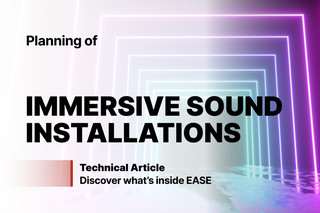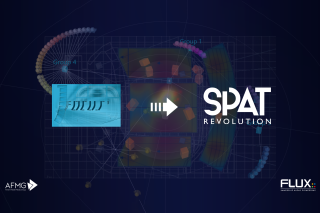
Introduction & Project Overview
Acoustic enhancement (electronic reverberation) systems are mostly the privilege of only the most renowned halls, demanding relatively large budgets for the multi-channel speaker layout and expensive audio processing units and software. Nevertheless, it is possible to keep budgets controlled while not sacrificing the required level of quality. In return, operators get a very flexible venue for a wide range of applications. This example of an EASE application shows electro-acoustic design and implementation of an acoustic enhancement system by Amadeus Active Acoustics in a large multipurpose hall, which, in addition, is made in a practical and an economical manner.
The Great Hall of the Congress Center Suhl (CCS), Germany, has a room volume of approx. 34,000 m³ and offers 2,350 seats, distributed over tiers and mobile seating stages. The hall already had used an acoustic enhancement technology (LARES) installed in the Great Hall in 1998, which raised the acoustically dry, treated hall with an RT of 1.4 s to numbers of 2 s for an occupied and 2.5 s for unoccupied state. The system, though, had an old configuration, and was felt to work inadequately. During orchestral performances there were complaints of the strong interference produced by the system's loudspeakers. A new system had to be planned.
Challenge
The main challenge of a good enhancement system is to guarantee the quality of the recreated spatial impression of the room and to maintain this quality while giving the stage manager or the in-house sound engineer the freedom to change this impression according to the type of music or performance. This means changing a preset or set of parameters to create a specific acoustic character for different event scenarios.
The particular challenge of this project was the long throw distance from the point-source wall loudspeakers to the center of the audience, due to the large dimensions of the hall. In this case, the early reflections generated by the point-source loudspeakers would be sufficient for auditory perception in one part of the audience, but could be disorientating in the other.
In addition, the freedom of placement of the enhancement loudspeakers was limited by the structural characteristics of the hall, as this time the aim was to extend the existing system layout and its resolution by introducing wall-mounted loudspeakers. The old system only had a ceiling layout.
The list of challenges further included budget constraints, microphone placement options and the right choice of acoustic enhancement processing unit.
Project Execution & Results
The practical side of the project consisted of several stages.
Firstly, the main portal sound system had to be planned, which was to be suspended from the ceiling. The design process was based on EASE simulations, which enabled the engineers to evaluate the mapping and distribution of acoustic parameters in the audience areas, and to achieve smooth coverage and uniformity of sound. Another important consideration in an electro-acoustic design is the weight of the loudspeakers, especially when it comes to rigging the ceiling-mounted line arrays. EASE covers this requirement as well, allowing to estimate the weight of each array in the system and the ability to compare different brands and layouts to suit the safety requirements of the venue. Ultimately, an 8-unit RCF line array solution based on the HDL-6A model was confirmed with EASE. In addition, a 5-unit center array was found to be necessary due to the width of the stage.
The mapping and distribution graphs in the image slider show the SPL and STI achieved by the 3 arrays. All three arrays operate at around 30 dB below their maximum capability, leaving plenty of headroom for smooth and stable reproduction. The STI is mostly above 0.6 throughout the hall, only 0.2% of the locations are below the 0.6 level marked 'good'.
The second stage of the design was to determine which, how many and where the enhancement loudspeakers would be installed, given the limited placement options. EASE provided a near real-time calculation of direct sound coverage and loudspeaker density, allowing layout ideas to be tested until the best solution was found.
The third stage was to validate the room acoustics in EASE, which was already in place with more than adequate acoustic treatment. A number of checks were also carried out taking into account the planned sound system.
The fourth stage was the correct selection and placement of the enhancement system microphones. EASE was particularly useful in determining the microphone placement zones for separate pickup of stage, audience and room response information. In particular, the critical distance room acoustic parameter and related acoustical data were examined in EASE to outline the zoning. As a result, 8 stage, 6 audience and 6 ceiling 'room response' microphones were selected and positioned to feed the appropriate processing units of the Amadeus reverberation enhancement system.
Finally, the Amadeus system processor had to be configured. The Amadeus system contains the algorithms for calculating early reflections with accurate source localization and late reverberation in real time. A reverb generator mimics the acoustic signature of the given room, taking into account the signals picked up by the stage and audience microphones. It also allows the impression of the room's acoustic properties to be manipulated, which can be controlled by the stage manager according to the type of performance. For example, the system can be set to sound full and spacious for a classical orchestra, or clean and focused for a vocal-oriented performance such as a musical or operetta. Also at this stage, EASE played an important role, providing valuable data for the correct setting of the enhancement system.
In conclusion, it is worth mentioning that during the planning phase it was possible to simulate the model in EASE with a high degree of accuracy and to make sensitive decisions with confidence. One of them was to leave the existing enhancement speakers on the ceiling. The simulation made it possible to see that it was not necessary to replace those loudspeakers (and the corresponding amplifiers and processing units), but rather to add a number of additional loudspeakers on the side walls so that the acoustic requirements could be sufficiently met and the budget of the project well reduced.
We thank ADA-AMC (WSDG Berlin) and Amadeus Active Acoustics for supporting this project example.













